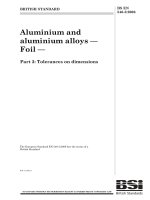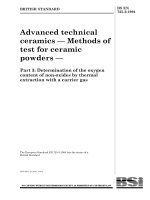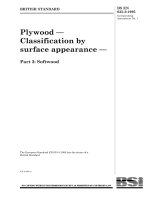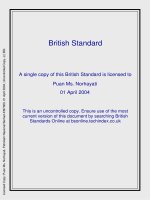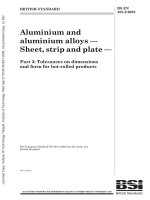Bsi bs en 61300 3 45 2011
Bạn đang xem bản rút gọn của tài liệu. Xem và tải ngay bản đầy đủ của tài liệu tại đây (1.22 MB, 18 trang )
BS EN 61300-3-45:2011
BSI Standards Publication
Fibre optic interconnecting
devices and passive
components — Basic
test and measurement
procedures
Part 3-45: Examinations and measurements —
Attenuation of random mated multi-fibre
connectors
BRITISH STANDARD
BS EN 61300-3-45:2011
National foreword
This British Standard is the UK implementation of EN 61300-3-45:2011. It is
identical to IEC 61300-3-45:2011.
The UK participation in its preparation was entrusted by Technical Committee
GEL/86, Fibre optics, to Subcommittee GEL/86/2, Fibre optic interconnecting
devices and passive components.
A list of organizations represented on this committee can be obtained on
request to its secretary.
This publication does not purport to include all the necessary provisions of a
contract. Users are responsible for its correct application.
© BSI 2011
ISBN 978 0 580 64523 5
ICS 33.180.20
Compliance with a British Standard cannot confer immunity from
legal obligations.
This British Standard was published under the authority of the Standards
Policy and Strategy Committee on 31 July 2011.
Amendments issued since publication
Amd. No.
Date
Text affected
BS EN 61300-3-45:2011
EUROPEAN STANDARD
EN 61300-3-45
NORME EUROPÉENNE
June 2011
EUROPÄISCHE NORM
ICS 33.180.20
English version
Fibre optic interconnecting devices and passive components Basic test and measurement procedures Part 3-45: Examinations and measurements Attenuation of random mated multi-fibre connectors
(IEC 61300-3-45:2011)
Dispositifs d'interconnexion et composants
passifs à fibres optiques Méthodes fondamentales d'essais et de
mesures Partie 3-45: Examens et mesures Affaiblissement dû à l'accouplement de
connecteurs quelconques multifibres
(CEI 61300-3-45:2011)
Lichtwellenleiter Verbindungselemente und passive
Bauteile Grundlegende Prüf- und Messverfahren Teil 3-45: Untersuchungen und
Messungen Dämpfung von zufällig gesteckten
Mehrfasersteckverbindern
(IEC 61300-3-45:2011)
This European Standard was approved by CENELEC on 2011-06-16. CENELEC members are bound to comply
with the CEN/CENELEC Internal Regulations which stipulate the conditions for giving this European Standard
the status of a national standard without any alteration.
Up-to-date lists and bibliographical references concerning such national standards may be obtained on
application to the Central Secretariat or to any CENELEC member.
This European Standard exists in three official versions (English, French, German). A version in any other
language made by translation under the responsibility of a CENELEC member into its own language and notified
to the Central Secretariat has the same status as the official versions.
CENELEC members are the national electrotechnical committees of Austria, Belgium, Bulgaria, Croatia, Cyprus,
the Czech Republic, Denmark, Estonia, Finland, France, Germany, Greece, Hungary, Iceland, Ireland, Italy,
Latvia, Lithuania, Luxembourg, Malta, the Netherlands, Norway, Poland, Portugal, Romania, Slovakia, Slovenia,
Spain, Sweden, Switzerland and the United Kingdom.
CENELEC
European Committee for Electrotechnical Standardization
Comité Européen de Normalisation Electrotechnique
Europäisches Komitee für Elektrotechnische Normung
Management Centre: Avenue Marnix 17, B - 1000 Brussels
© 2011 CENELEC -
All rights of exploitation in any form and by any means reserved worldwide for CENELEC members.
Ref. No. EN 61300-3-45:2011 E
BS EN 61300-3-45:2011
EN 61300-3-45:2011
-2-
Foreword
The text of document 86B/3177/FDIS, future edition 1 of IEC 61300-3-45, prepared by SC 86B, Fibre
optic interconnecting devices and passive components, of IEC TC 86, Fibre optics, was submitted to the
IEC-CENELEC parallel vote and was approved by CENELEC as EN 61300-3-45 on 2011-06-16.
Attention is drawn to the possibility that some of the elements of this document may be the subject of
patent rights. CEN and CENELEC shall not be held responsible for identifying any or all such patent
rights.
The following dates were fixed:
– latest date by which the EN has to be implemented
at national level by publication of an identical
national standard or by endorsement
(dop)
2012-03-16
– latest date by which the national standards conflicting
with the EN have to be withdrawn
(dow)
2014-06-16
Annex ZA has been added by CENELEC.
__________
Endorsement notice
The text of the International Standard IEC 61300-3-45:2011 was approved by CENELEC as a European
Standard without any modification.
__________
-3-
BS EN 61300-3-45:2011
EN 61300-3-45:2011
Annex ZA
(normative)
Normative references to international publications
with their corresponding European publications
The following referenced documents are indispensable for the application of this document. For dated
references, only the edition cited applies. For undated references, the latest edition of the referenced
document (including any amendments) applies.
NOTE When an international publication has been modified by common modifications, indicated by (mod), the relevant EN/HD
applies.
Publication
Year
Title
EN/HD
Year
IEC 61300-1
-
Fibre optic interconnecting devices and
passive components - Basic test and
measurement procedures Part 1: General and guidance
EN 61300-1
-
IEC 61300-3-1
-
Fibre optic interconnecting devices and
passive components - Basic test and
measurement procedures Part 3-1: Examinations and measurements Visual examination
EN 61300-3-1
-
IEC 61300-3-35
-
EN 61300-3-35
Fibre optic interconnecting devices and
passive components - Basic test and
measurement procedures Part 3-35: Examinations and measurements Fibre optic cylindrical connector endface
visual and automated inspection
IEC 61754
Series Fibre optic connector interfaces
EN 61754
-
Series
–2–
BS EN 61300-3-45:2011
61300-3-45 IEC:2011
CONTENTS
1
Scope ............................................................................................................................... 5
2
Normative references........................................................................................................ 5
3
General description ........................................................................................................... 5
4
3.1 Test methods .......................................................................................................... 5
3.2 Precautions ............................................................................................................. 6
Apparatus ......................................................................................................................... 7
5
4.1 Source (S) ............................................................................................................... 7
4.2 Launch conditions (E) .............................................................................................. 7
4.3 Detector (D)............................................................................................................. 7
Procedure ......................................................................................................................... 8
6
5.1 Method 1 ................................................................................................................. 8
5.2 Method 2 ............................................................................................................... 10
5.3 Analysis of results ................................................................................................. 13
Details to be specified ..................................................................................................... 13
Figure 1 – “Reference” cord measurement – Method 1 ............................................................ 8
Figure 2 – Test cord measurement – Method 1 ........................................................................ 8
Figure 3 – Test matrix and labelling for measuring method 1 (2-fibre connector) ..................... 9
Figure 4 – Test matrix and labelling for measuring method 1 (4-fibre connector) .................... 10
Figure 5 – Test matrix and labelling for measuring method 1 (8, 10, 12-fibre connector)......... 10
Figure 6 – “Reference” cord measurement (1) – Method 2 ..................................................... 11
Figure 7 – Test cord measurement (1) – Method 2 ................................................................. 11
Figure 8 – “Reference” cord measurement (2) – Method 2 ..................................................... 12
Figure 9 – Test cord measurement (2) – Method 2 ................................................................. 12
Figure 10 – Test matrix and labelling for measuring method 2 (2-fibre connector) .................. 12
Figure 11 – Test matrix and labelling for measuring method 2 (4-fibre connector) .................. 13
Figure 12 – Test matrix and labelling for measuring method 2 (8, 10, 12-fibre connector) ....... 13
Table 1 – Sample size for Method 1......................................................................................... 6
Table 2 – Sample size for Method 2......................................................................................... 6
BS EN 61300-3-45:2011
61300-3-45 IEC:2011
–5–
FIBRE OPTIC INTERCONNECTING DEVICES
AND PASSIVE COMPONENTS –
BASIC TEST AND MEASUREMENT PROCEDURES –
Part 3-45: Examinations and measurements –
Attenuation of random mated multi-fibre connectors
1
Scope
The purpose of this part of IEC 61300 is to describe the procedure required to measure the
statistical distribution and mean attenuation for random mated optical connectors with physical
contact (PC) and angled physical contact (APC) polished 1-row multi-fibre rectangular ferrules
as defined in the IEC 61754 series. This measurement method is applicable to cable
assemblies.
2
Normative references
The following referenced documents are indispensable for the application of this document. For dated
references, only the edition cited applies. For undated references, the latest edition of the
referenced document (including any amendments) applies.
IEC 61300-1, Fibre optic interconnecting devices and passive components – Basic test and
measurement procedures – Part 1: General and guidance
IEC 61300-3-1, Fibre optic interconnecting devices and passive components – Basic test and
measurement procedures – Part 3-1: Examinations and measurements – Visual examination
IEC 61300-3-35, Fibre optic interconnecting devices and passive components – Basic test and
measurement procedures – Part 3-35: Examinations and measurements – Fibre optic
connector endface visual and automated inspection
IEC 61754 (all parts), Fibre optic connector interfaces
3
3.1
General description
Test methods
Two test methods are described for measuring the attenuation of random mated optical
connectors. Both provide an estimate of the expected average performance that a group of
cable assemblies (including an adaptor, if applicable) selected from a batch will exhibit when
used in an optical system. The cable assemblies, and any adaptors, must be chosen at random
to ensure that the measurements provide a statistically unbiased estimate.
Method 1 describes the procedure using a sample of cable assemblies and adaptors specified
in Table 1. In this case the plugs (with pins) are used as “reference” plugs and the plugs
(without pins) are tested against them sequentially. The results, based on the number of
measurements specified in Table 1, are recorded in the test matrix shown in Figures 3 to 5.
Method 1 is intended to be part of a design approval exercise that may involve one or more
suppliers. Once approval is achieved, Method 2 would be relied on to maintain process control.
However, in the event of a dispute, Method 1 shall act as the reference measurement method.
BS EN 61300-3-45:2011
61300-3-45 IEC:2011
–6–
Method 2 describes a procedure for the measurement of a sample of cable assemblies
specified in Table 2.
Three cable assemblies are selected from the sample as “reference” cable assemblies and
pins are fitted. The other test cable assemblies (without pins) are tested against each of the
three “reference cable assemblies” sequentially. This produces the number of measurements
specified in Table 2 and the results are recorded in the test matrix shown in Figures 10 to 12.
It is recognised that the number of measurements required by Method 1 may be excessive for
day-to-day routine checking of either in-house or supplier produced products. In this case, as
indicated above, Method 2 may be an alternative option.
NOTE In this measurement method, the terms “reference” plug or “reference” cord are used to define those
components chosen at random from a batch, against which a number of comparative measurements are made. It is
not intended that the terms should imply specially chosen or manufactured components, such as those used, for
example, in screen testing.
Table 1 – Sample size for Method 1
Connector
Sample size
(n-fibre connector)
Cord and adaptors
Measurements
Fibres
2-fibre connector
15
210
420
4-fibre connector
12
132
528
8-fibre connector
10
90
720
10-fibre connector
10
90
900
12-fibre connector
10
90
1 080
Measurements
Fibres
Table 2 – Sample size for Method 2
Sample size
Connector
(n-fibre connector)
Cord and adaptors
Total
Reference
Test :N
2-fibre connector
12
3
9
54
108
4-fibre connector
8
3
5
30
120
8-fibre connector
6
3
3
18
144
10-fibre connector
6
3
3
18
180
12-fibre connector
6
3
3
18
216
3.2
Precautions
The following test requirements shall be met.
a) Precautions shall be taken to ensure that the cladding modes do not affect the
measurement. Cladding modes shall be stripped as a function of the fibre coating.
b) Precautions shall be taken to ensure that the position of the fibres in the test remains fixed
between the measurement of P 1 and P 2 to avoid changes in attenuation due to bending
losses.
c) The stability performance of the test equipment shall be ≤ 0,05 dB or 10 % of the
attenuation to be measured, whichever is the lower value. The stability shall be maintained
over the measurement time and operational temperature range. The required measurement
resolution shall be 0,01 dB for both multimode and single mode.
BS EN 61300-3-45:2011
61300-3-45 IEC:2011
–7–
d) To achieve consistent results, clean and inspect all connectors and adaptors prior to
measurement. Visual examination shall be undertaken in accordance with IEC 61300-3-1
and IEC 61300-3-35.
NOTE A cladding mode stripper usually comprises a material having a refractive index equal to or greater than
that of the fibre cladding.
4
Apparatus
4.1
Source (S)
The source consists of an optical emitter, the means to connect to it and associated drive
electronics. In addition to meeting the stability and power level requirements, the source shall
have the following characteristics:
–
Centre wavelength, as detailed in the performance and product standard;
–
Spectral width, filtered light emitting diode (LED) ≤ 150 nm full width half maximum
(FWHM);
–
Spectral width, laser diode (LD) < 10 nm FWHM.
For multimode fibres, broadband sources such as an LED shall be used.
For single mode fibres either an LED or LD may be used.
NOTE The interference of modes from a coherent source will create speckle patterns in multimode fibres. These
speckle patterns give rise to speckle or modal noise and are observed as power fluctuations, since their
characteristic times are longer than the resolution time of the detector. As a result, it may be impossible to achieve
stable launch conditions using coherent sources for multimode measurements. Consequently, lasers, including
optical time domain reflectometer (OTDR) sources, should be avoided in favour of LEDs or other incoherent
sources for measuring multimode components.
4.2
Launch conditions (E)
The launch condition shall be specified in accordance with IEC 61300-1.
4.3
Detector (D)
The detector consists of an optical detector, the means to connect to it and associated
electronics. The connection to the detector will be an adaptor that accepts a connector plug of
the appropriate design. The detector shall capture all light emitted by the connector plug.
In addition to meeting the stability and resolution requirements, the detector shall have the
following characteristics:
–
Linearity of multimode, ≤ ±0,25 dB (over −5 dBm up to −60 dBm);
–
Linearity of single mode, ≤ ±0,1 dB (over −5 dBm up to −60 dBm).
NOTE
The power meter linearity should be referenced to a power level of −23 dBm at the operational wavelength.
Where the connection to the detector is broken between the measurement of P 1 and P 2 , the
measurement repeatability shall be within 0,05 dB or 10 % of the attenuation to be measured,
whichever is the lower value. A large sensitive area detector may be used to achieve this.
The precise characteristics of the detector shall be compatible with the measurement
requirements. The dynamic range of the power meter shall be capable of measuring the power
level exiting from the device under test (DUT) at the wavelength being measured.
BS EN 61300-3-45:2011
61300-3-45 IEC:2011
–8–
5
Procedure
5.1
Method 1
a) Randomly select the sample number of cable assemblies specified in Table 1. Sequentially
label the plugs under test as shown in Figures 3 to 5.
b) Randomly select the sample size of adaptors as specified in Table 1. Sequentially label the
adaptors under test as shown in Figures 3 to 5.
c) Set up the measurement system as shown in Figure 1, with cord 1as the “reference” cord
and with plug 1 as the “reference” plug. Measure power P 1-1 to P 1-n for all fibres in the
cord.
S
“Reference” cord
Fan-out cord
Ch 1
D
E
Plug
1(without pins)
Plug
1(with pins)
Ch n
P1-n
IEC 900/11
Figure 1 – “Reference” cord measurement – Method 1
d) Connect test cord 2 and adaptor 1 to the system and mate plug 1 (with pins) to plug 2
(without pins) as shown in Figure 2. Measure the power P 2-1 to P 2-n for all fibres in the
cord.
Ch 1
Test cord
D
E
S
Adaptor 1
“Reference” cord
Fan-out cord
Plug 1
(without pins)
Plug 1
(with pins)
Plug 2
(without pins)
Plug 2
(with pins)
P2-n
Ch n
IEC 901/11
Figure 2 – Test cord measurement – Method 1
e) Calculate the attenuation of the mated plug pair 1 (with pins) / 2 (without pins) with adaptor
1, using Equation (1):
Attenuation = [-10 log (P 2-i /P 1-i )] - (A × L) dB
(1)
Where
i
is fibre number of Test cord.
A
is fibre attenuation per km;
L
is length of fibre in km.
NOTE The product A × L may be ignored for both single mode and multimode [50/125 µm and 62,5/125 µm] where
the cord length is small, i.e. < 10 m.
f)
Record the attenuation results for each fibre into an appropriate matrix format.
NOTE
An example of record table (for 4 fibre connectors) is shown in Figure 13.
g) Keeping plug 1 (with pins) and adaptor 1 as the “reference” configuration, replace test cord
2 by test cord 3 and mate plug 3 (without pins) with plug 1 (with pins).
BS EN 61300-3-45:2011
61300-3-45 IEC:2011
–9–
h) Measure the power P 3-1 to P 3-n and record the attenuation results for each fibre.
i) Repeat steps g) and h) until all the plugs (without pins) of the remaining test cable
assemblies have been tested against the “reference” plug 1 (with pins).
j)
After step i) has been completed, replace the “reference” plug and adaptor so that plug 2
(with pins) and adaptor 2 are the “reference” configuration.
k) Measure the attenuation for all plugs against “reference” plug 2 (with pins) and adaptor 2.
l)
Continue this process until all allocated plugs have been used as “reference” plugs.
“ Reference”
Configuration
Plug 1 (with pins)
Adaptor 1
Plug 2 (with pins)
Adaptor 2
Plug 3 (with pins))
Adaptor 3
Plug 4 (with pins)
Adaptor 4
Plug 5 (with pins)
Adaptor 5
Plug 6 (with pins)
Adaptor 6
Plug 7 (with pins)
Adaptor 7
Plug 8 (with pins)
Adaptor 8
Plug 9 (with pins)
Adaptor 9
Plug 10 (with pins)
Adaptor 10
Plug 11 (with pins)
Adaptor 11
Plug 12 (with pins)
Adaptor 12
Plug 13 (with pins)
Adaptor 13
Plug 14 (with pins)
Adaptor 14
Plug 15 (with pins)
Adaptor 15
1
2
3
4
5
Test cord and labelling
Plug (without pins)
6
7
8
9
10
11
12
13
14
15
IEC
Figure 3 – Test matrix and labelling for measuring Method 1 (2-fibre connector)
902/11
BS EN 61300-3-45:2011
61300-3-45 IEC:2011
– 10 –
“ Reference”
configuration
1
Plug 1 (with pins)
Adaptor 1
Plug 2 (with pins)
Adaptor 2
Plug 3 (with pins)
Adaptor 3
Plug 4 (with pins)
Adaptor 4
Plug 5 (with pins)
Adaptor 5
Plug 6 (with pins)
Adaptor 6
Plug 7 (with pins)
Adaptor 7
Plug 8 (with pins)
Adaptor 8
Plug 9 (with pins)
Adaptor 9
Plug 10 (with pins)
Adaptor 10
Plug 11 (with pins)
Adaptor 11
Plug 12 (with pins)
Adaptor 12
2
3
Test cord and labelling
Plug (without pins)
4
5
6
7
8
9
10
11
12
IEC
903/11
Figure 4 – Test matrix and labelling for measuring Method 1 (4-fibre connector)
“ Reference”
configuration
Plug 1 (with pins)
Adaptor 1
Plug 2 (with pins)
Adaptor 2
Plug 3 (with pins)
Adaptor 3
Plug 4 (with pins)
Adaptor 4
Plug 5 (with pins)
Adaptor 5
Plug 6 (with pins)
Adaptor 6
Plug 7 (with pins)
Adaptor 7
Plug 8 (with pins)
Adaptor 8
Plug 9 (with pins)
Adaptor 9
Plug 10 (with pins)
Adaptor 10
1
2
Test cord and labelling
Plug (without pins)
3
4
5
6
7
8
9
10
IEC
904/11
Figure 5 – Test matrix and labelling for measuring Method 1 (8, 10, 12-fibre connector)
5.2
Method 2
a) Randomly select the sample number of cable assemblies specified in Table 2.
b) Choose three cable assemblies at random and sequentially label the plugs of each cord as
“reference” plugs. Sequentially label the plugs of the remaining cable assemblies as test
plugs. Sequentially label three adaptors 1 to 3 (as shown in Figures 10 to 12).
c) Set up the measurement system as shown in Figure 6, with “reference” cord 1 so that the
plug 1 (with pins) is the “reference” plug. Measure power P 1-1 to P 1-n for all fibres in the
cord.
BS EN 61300-3-45:2011
61300-3-45 IEC:2011
– 11 –
S
“Reference” cord
Fan-out cord
Ch 1
D
E
Plug 1
(without pins)
Plug 1
(with pins)
Ch n
P1-n
IEC 905/11
Figure 6 – “Reference” cord measurement (1) – Method 2
d) Connect test cord 2 and adaptor 1 to the measurement system and mate reference plug 1
(with pins) with test plug 2 (without pins) as shown in Figure 7. Measure the power P 2-1 to
P 2-n .
Ch 1
Test cord
D
E
S
Adaptor 1
“Reference” cord
Fan-out cord
Plug 1
(without pins)
Plug 1
(with pins)
Plug 2
(without pins)
Plug 2
(with pins)
P2-n
Ch n
IEC 906/11
Figure 7 – Test cord measurement (1) – Method 2
e) Calculate the attenuation of the mated plug pair 1 (with pins) / 2 (without pins) with adaptor
1, using Equation (2):
Insertion loss = [-10 log (P 2-i /P 1-i )] - (A × L) dB
(2)
Where
i
is fiber number of Test cord
A
is fibre attenuation per km
L
is length of fibre in km
NOTE The product A × L may be ignored for both single mode and multimode [50/125 µm and 62.5/125 µm] where
the cord length is small, i.e. < 10 m.
f)
Record the attenuation results for each fibre into an appropriate matrix format.
g) Repeat steps d) to f) until all test plugs (without pins) have been tested against “reference”
plug 1 (with pins) and adaptor 1.
h) After step g) has been completed, replace the “reference” plug and adaptor so that
“reference” plug 2 (with pins) and adaptor 2 are the “reference” configuration.
i)
Measure the attenuation for all test plugs (without pins) against “reference” plug 2 (with
pins) and adaptor 2, using the procedures described above.
j)
Continue this process until all allocated “reference” plugs (with pins) and adaptors have
been used and all test cable assemblies (without pins) have been tested.
k) S et up the measurement system shown in Figure 8, with “reference” cord 1 so that the plug
(without pins) 1 is the “reference” plug, Measure power P 1-1 to P 1-n for all fibres in the cord.
BS EN 61300-3-45:2011
61300-3-45 IEC:2011
– 12 –
“Reference” cord
Fan-out cord
Ch 1
S
D
E
Plug 1
(with pins)
Plug 1
(without pins)
Ch n
P1-n
IEC 907/11
Figure 8 – “Reference” cord measurement (2) – Method 2
l)
Connect test cord 2 and adaptor 1 to the measurement system and mate “reference” plug 1
(without pins) with test plug 2 (with pins) as shown in Figure 9. Measure the power P 2-1 to
P 2-n .
Ch 1
Fan-out cord
Test cord
D
E
S
Adaptor 1
“Reference” cord
Plug 2
(without pins)
Plug 2
Plug 1
(without pins) (with pins)
Plug 1
(with pins)
P2-n
Ch n
IEC 908/11
Figure 9 – Test cord measurement (2) – Method 2
m) Calculate the attenuation of the mated plug pair 1 (without pins) / 2 (with pins) with adaptor
1, using the equation given above.
n) Record the attenuation results for each fibre into an appropriate matrix format.
o) Repeat steps l) to n) until all test plugs (with pins) have been tested against the “reference”
plug 1 (without pins) and adaptor 1.
p) After step m) has been completed, replace the “reference” plug and adaptor so that
“reference” plug 2 (without pins) and adaptor 2 are the “reference” configuration.
q) Measure the attenuation for all test plugs (with pins) against “reference” plug 2 (without
pins) and adaptor 2, using the procedures described above.
r)
Continue this process until all allocated “reference” plugs (without pins) and adaptors have
been used and all test cable assemblies (with pins) have been tested.
“ Reference”
Configuration (1)
“Reference” Plug
Adaptor
Plug 1 (with pins)
Adaptor 1
Plug 2 (with pins)
Adaptor 2
Plug 3 (with pins)
Adaptor 3
“ Reference”
Configuration (2)
“Reference” Plug
Adaptor
Plug 1 (without pins)
Adaptor 1
Plug 2 (without pins)
Adaptor 2
Plug 3 (without pins)
Adaptor 3
Test cord and labelling
Test plug (without pins)
1
2
3
4
5
6
7
8
9
8
9
Test cord and labelling
Test plug (with pins)
1
2
3
4
5
6
7
IEC
909/11
Figure 10 – Test matrix and labelling for measuring Method 2 (2-fibre connector)
BS EN 61300-3-45:2011
61300-3-45 IEC:2011
– 13 –
“ Reference”
Configuration (1)
“Reference” Plug
Adaptor
Plug 1 (with pins)
Adaptor 1
Plug 2 (with pins)
Adaptor 2
Plug 3 (with pins)
Adaptor 3
“ Reference”
Configuration (2)
“Reference” Plug
Adaptor
Plug 1 (without pins)
Adaptor 1
Plug 2 (without pins)
Adaptor 2
Plug 3 (without pins)
Adaptor 3
Test cord and labelling
Test plug (without pins)
1
2
3
4
5
Test cord and labelling
Test plug (with pins)
1
2
3
4
5
IEC
910/11
Figure 11 – Test matrix and labelling for measuring Method 2 (4-fibre connector)
“ Reference”
Configuration (1)
“Reference” Plug
Adaptor
Plug 1 (with pins)
Adaptor 1
Plug 2 (with pins)
Adaptor 2
Plug 3 (with pins)
Adaptor 3
“ Reference”
Configuration (2)
“Reference” Plug
Adaptor
Plug 1 (without pins)
Adaptor 1
Plug 2 (without pins)
Adaptor 2
Plug 3 (without pins)
Adaptor 3
Test cord and
labelling
Test plug (without pins)
1
2
3
Test cord and
labelling
Test plug (with pins)
1
2
3
IEC
911/11
Figure 12 – Test matrix and labelling for measuring Method 2 (8, 10, 12-fibre connector)
5.3
Analysis of results
The mean value and 97 % percentile values of the measurement data from all the fibres of
either Method 1 or Method 2, shall comply with the values specified in the relevant connector
performance standard.
6
Details to be specified
The following details, as applicable, shall be specified in the relevant specification.
•
Performance characteristics (allowable attenuation, statistical variation, etc.).
•
Source wavelength.
•
Fibre attenuation per km.
•
Deviations from this test method.
___________
This page deliberately left blank
This page deliberately left blank
NO COPYING WITHOUT BSI PERMISSION EXCEPT AS PERMITTED BY COPYRIGHT LAW
British Standards Institution (BSI)
BSI is the national body responsible for preparing British Standards and other
standards-related publications, information and services.
BSI is incorporated by Royal Charter. British Standards and other standardization
products are published by BSI Standards Limited.
About us
Revisions
We bring together business, industry, government, consumers, innovators
and others to shape their combined experience and expertise into standards
-based solutions.
Our British Standards and other publications are updated by amendment or revision.
The knowledge embodied in our standards has been carefully assembled in
a dependable format and refined through our open consultation process.
Organizations of all sizes and across all sectors choose standards to help
them achieve their goals.
Information on standards
We can provide you with the knowledge that your organization needs
to succeed. Find out more about British Standards by visiting our website at
bsigroup.com/standards or contacting our Customer Services team or
Knowledge Centre.
Buying standards
You can buy and download PDF versions of BSI publications, including British
and adopted European and international standards, through our website at
bsigroup.com/shop, where hard copies can also be purchased.
If you need international and foreign standards from other Standards Development
Organizations, hard copies can be ordered from our Customer Services team.
Subscriptions
Our range of subscription services are designed to make using standards
easier for you. For further information on our subscription products go to
bsigroup.com/subscriptions.
With British Standards Online (BSOL) you’ll have instant access to over 55,000
British and adopted European and international standards from your desktop.
It’s available 24/7 and is refreshed daily so you’ll always be up to date.
You can keep in touch with standards developments and receive substantial
discounts on the purchase price of standards, both in single copy and subscription
format, by becoming a BSI Subscribing Member.
PLUS is an updating service exclusive to BSI Subscribing Members. You will
automatically receive the latest hard copy of your standards when they’re
revised or replaced.
To find out more about becoming a BSI Subscribing Member and the benefits
of membership, please visit bsigroup.com/shop.
With a Multi-User Network Licence (MUNL) you are able to host standards
publications on your intranet. Licences can cover as few or as many users as you
wish. With updates supplied as soon as they’re available, you can be sure your
documentation is current. For further information, email
BSI Group Headquarters
389 Chiswick High Road London W4 4AL UK
We continually improve the quality of our products and services to benefit your
business. If you find an inaccuracy or ambiguity within a British Standard or other
BSI publication please inform the Knowledge Centre.
Copyright
All the data, software and documentation set out in all British Standards and
other BSI publications are the property of and copyrighted by BSI, or some person
or entity that owns copyright in the information used (such as the international
standardization bodies) and has formally licensed such information to BSI for
commercial publication and use. Except as permitted under the Copyright, Designs
and Patents Act 1988 no extract may be reproduced, stored in a retrieval system
or transmitted in any form or by any means – electronic, photocopying, recording
or otherwise – without prior written permission from BSI. Details and advice can
be obtained from the Copyright & Licensing Department.
Useful Contacts:
Customer Services
Tel: +44 845 086 9001
Email (orders):
Email (enquiries):
Subscriptions
Tel: +44 845 086 9001
Email:
Knowledge Centre
Tel: +44 20 8996 7004
Email:
Copyright & Licensing
Tel: +44 20 8996 7070
Email:


